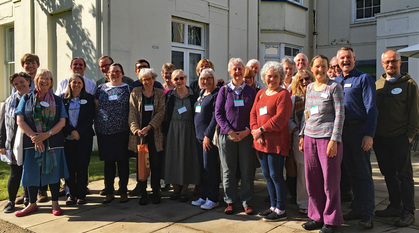Sowing the seeds of Quakerism
Maísa Monteiro discusses the inspiration behind the theme of this year's contributions pack.

Have you planted any seeds this year? Some people have found solace in gardening during lockdowns. For me gardening has been good for my wellbeing. When I touch the soil I picture the plant that I am cultivating coming into bloom. Others have had more time to take care of house plants and window boxes. Maybe you've planted metaphorical seeds: ideas, projects, relationships. Maybe someone planted a seed in your mind.
It is the time of year when we invite Friends to support the work of Britain Yearly Meeting, and we do our best to convey the breadth and depth of work with and for Quakers.
Last year I was inspired to base the contribution material on a tree image explaining what BYM stood for and all our diverse activities. Keeping with the theme of plants, seeds and saplings, I chose this year's title of the contribution pack for 2022: Sowing the seeds of Quakerism. The BYM design team did a fantastic job visualising that idea.
Quakers of course try to search out the 'seeds of war' in their own lives, but what are the seeds we want to plant?
Envisioning hope and optimism
Sowing the seeds of Quakerism conveys hope and longevity for what I perceive of Quakers and Quakerism, the long history of activism and trying to bring justice into the world. I am actually not a Quaker myself, but this is how I perceive the work as I learn about it. Although hope and optimism have felt in short supply over the last few years with the pandemic, the work Quakers are committed to is about envisioning something better that can grow out of our present. I hope that it brings you the same optimism.
The hands holding the sapling is more than just background: to me it conveys resilience and strength of what Quakers have endured through times. It takes not only hope but courage to sow seeds when the future is uncertain. I see this image as showing how the future of Quakerism sits in the hands of Quakers.
The soil represents Quakerism. When watered with activism and witness through action then the seeds start to grow and surface, symbolising a new chapter, a new beginning to the full cycle of life.
Planting in fertile soil
Each year the plant becomes stronger and more robust. Later it will be self-seeding so as they flower and flourish the seeds are spread all around and start the life cycle again. With Quakers and so many others part of the movement for climate justice, not least at COP26 this November, the image of a growing plant is not just a metaphor.
Local Development Workers, who are based in different parts of Britain, are in a way the gardeners who can help the seeds grow in Quaker communities. I am reminded that the seeds that grow the strongest are those planted in the most fertile soil, which for Quakers is perhaps that mixture of faith and witness in action.
While writing this blog the words by author Sally Clarkson stuck with me, "To take all of the planting of faith seeds, and love seeds, and integrity seeds, and faithfulness seeds, into the moments of our lives when no one else is looking". To me it translated into a feeling of renewal, of plants flowering together in future hope.
We hope that all members and attenders have the opportunity to support the centrally managed work of Quakers. We invite you all to view, download and share our latest contributions pack (PDF: England and Wales) (PDF: Scotland) and help us spread the seeds of Quakerism widely.


